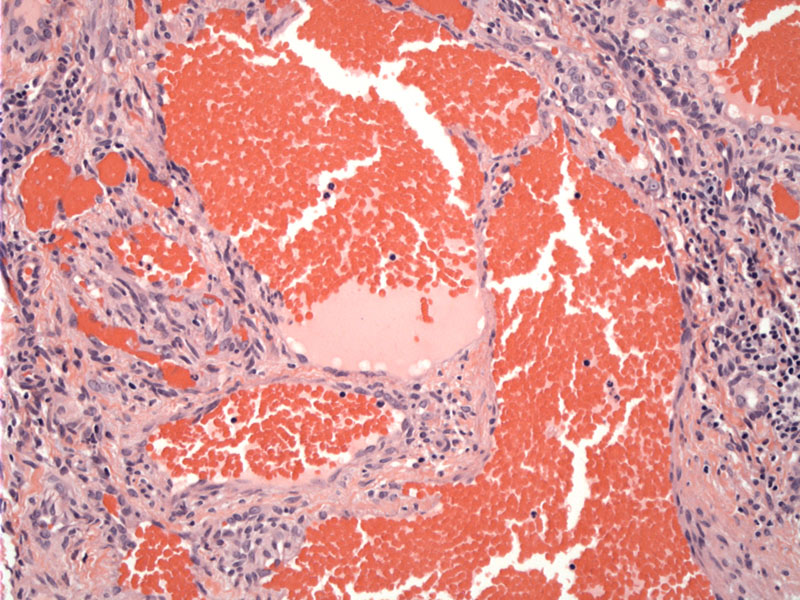System: Soft Tissue: Vascular: Neoplastic: Spindle Cell Hemangioma

System: Soft Tissue: Vascular: Neoplastic: Spindle Cell Hemangioma



Case 1: Irregular dilated vascular spaces filled with RBCs resemble cavernous hemangioma.
The walls of the vessels are filled with spindled cells forming slit-like vessels, which may be compressed -- this cellular component can be quite solid.
Spindle cell hemangiomas, originally described as spindle cell hemangioendotheliomas, have features resembling both a cavernous hemangioma and Kaposi sarcoma. They are benign and likely reactive lesions.
Grossly, spindle cell hemangiomas are usually firm red-brown nodules and are well-circumscribed. Some contain thrombi or calcifications.
Microscopically, there are two distinct components: (1) cavernous or dilated blood vessels lined by flattened endothelial cells - resembling a caverous hemagioma (2) a cellular zone composed of a proliferation of spindled pericytes and fibroblastic cells that form slit-like vascular spaces -- resmbling Kaposi sarcoma. The spindled cells may be round or epithelioid, sometimes containing vacuoles and intracytoplasmic lumens. There is minimal to absent mitotic activity. The spindled or vacuolated endothelial cells are positive for CD31, CD34, FLI1 and vWF. The spindled pericytes are positive for SMA and desmin (Folpe).
The differential diagnosis includes angiosarcoma (exhibits more nuclear atypia, mitotic activity, necrosis and infiltrative borders -- SCH is well circumscribed), Kaposi sarcoma (again, not as well circumscribed as SCH, KS lacks the vacuolated endothelial cells and has an associated chronic inflammatory infiltrate, absent in SCH)(Folpe).
In a review of 78 cases of SCH (Perkins et al. 1996), the mean age was 34 (range of 8-78). These tumors are small, subcutaneous and circumscribed -- and tend to affect the distal extremities (forearm/hand, distal leg/foot). There is a tendency to grow continguously along a vessel. Half the cases were intravascular. Approximately 5% of patients with SCH have Maffucci syndrome -- with hemangiomas and enchondromas.
Spindle cell hemangiomas are benign lesions with no metastatic potential, although 60% recur locally.
→A subset of cases are associated with Marfucci syndrome.
→Histologically composed of two components: a component resembling cavernous hemangioma and a cellular component resembling Kaposi sarcoma.
Folpe AL, Inwards CY. Bone and Soft Tissue Pathology: Foundations in Diagnostic Pathology Philadelphia, PA: Elsevier; 2010: 173-5.
Perkins P, Weiss SW. Spindle cell hemangioendothelioma. An analysis of 78 cases with reassessment of its pathogenesis and biologic behavior. Am J Surg Pathol. 1996 Oct;20(10):1196-204.